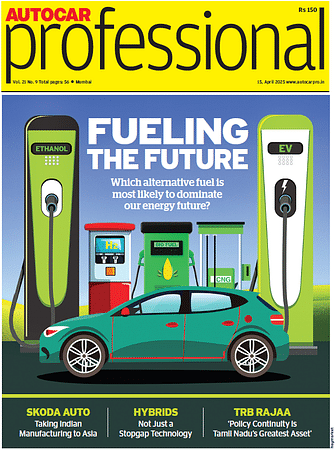FY25: A Year of Revival for the 2-Wheeler Industry
After underperforming other categories, the two-wheeler industry topped the charts in FY25 to emerge as the fastest growing auto segment, thanks to reviving rural sentiment and new launches.
Two-wheelers stole the spotlight in financial year 2025 as the only segment to register a high singledigit growth in volumes during the year. The year witnessed a strong uptick in rural demand, with a slew of new launches keeping the market buzzing. The growth has been timely too, given that two-wheelers remain the only segment yet to fully recoup its sales after the pandemic setback.
The financial year saw strong demand in the domestic market, buttressed by robust exports. This was further boosted by a strong uptick in the demand for electric vehicles, growing premiumization, and an intensifying fight between Hero MotoCorp and Honda for the top slot.
Domestic Market
During FY25, automakers in India dispatched a total of 19.61 million two-wheelers into the domestic market, according to data from the Society of Indian Automobile Manufacturers (SIAM). This represents a growth of 9.1% compared to the financial year 2024.
Passenger vehicles and threewheelers witnessed moderate growth on account of the highbase effect during the financial year while the two-wheeler segment registered strong growth, said SIAM President Shailesh Chandra.
According to the FADA, twowheeler retail sales in 2024-25 rose 7.1% on year to 18.88 million units. The robust growth can be largely attributed to a resurgence in rural demand and a renewed sense of consumer confidence, which have collectively helped the segment regain momentum.
Strong Rural Demand
Underlying the strong performance in the domestic segment was a rural market casting off its sluggishness, as data shared by the Federation of Automobile Dealers Associations (FADA) also highlights. The data showed that rural India emerged as a stronger growth engine for two-wheeler sales, witnessing an 8.39% expansion, notably higher than the 6.77% growth recorded in urban markets.
This is all the more notable, given that the rural market had been a drag on the overall numbers since the pandemic ended. Estimates suggest that 40-50% of the two-wheelers sales in India take place in rural India, where they are seen as a practical mode of transportation offering essential and affordable mobility.
While the urban market continues to embrace electric mobility, rural India continues to be the backbone of the domestic two-wheeler market, particularly in the affordable segment. Despite the relative outperformance, FADA President CS Vigneshwar noted that two-wheeler sales at dealerships fell short of expectations. “While we hoped for double digits in two-wheelers, we ended up at 7.71%,” he said.
Segmentation
The scooter segment took the lead in the revival, buoyed by better connectivity in rural and semi-urban areas, along with a wave of new models offering enhanced features that cater to evolving consumer preferences. The SIAM data showed domestic scooter dispatches jumped around 17% to an all-time high of 6.85 million units, accounting for almost 35% of the two-wheeler dispatches.
In the previous year, scooters accounted for around 32% of the two-wheeler volume. Motorcycle dispatches, on the other hand, grew only 5.1% to 12.25 million units. Motorcycle models with engine capacity of up to 125cc grew in line with the market, accounting for 75.5%, almost same from the year-ago period. In contrast, the share of entry-level models—with capacity of 110cc and below— declined to 46% from 48.4% with volumes remaining almost flat.
Two-wheeler exports bounced back after two straight years of decline with a strong double-digit growth, with a total of 4.20 million units exported, up 21.4%. “New models and new markets have helped in expanding the footprint of two-wheeler exports. Further, economic stability in the African region and demand in Latin America has supported this growth,” said SIAM.
The Fight for the Crown
Amid all this, a fight has been brewing between the No.1 and its long-time rival. Despite a strong challenge from Honda, Hero MotoCorp held on to its crown in the domestic two-wheeler market during the financial year 2025, both in the retail and wholesale volumes.
However, the fight seems to have only begun, with Honda growing faster and even outselling Hero in certain months of the last financial year. Honda Motorcycle and Scooter India significantly narrowed the market share gap, as Hero MotoCorp’s market share fell for the second year in a row.
This was reflected in both retail and wholesale numbers. As per FADA’s data, Hero MotoCorp’s retail market share declined to 28.84% during FY25, down from 30.79% the previous year. In contrast, Honda’s share improved to 25.37% from 23.36%. This was because of the difference in growth rates. While Hero MotoCorp saw a marginal increase of only 1% in sales to 54.45 lakh units, Honda recorded a 17% surge in retail sales to 47.89 lakh units.
A revival in scooter sales yielded great benefits for Honda, given its No.1 position in the scooter market with over 40% market share. It also benefited from incremental volumes from the Shine 100 and some premium models. Riding on the strong growth momentum, Honda’s management recently stated the company is well within reach of becoming “the largest market shareholder in India."
Hero would have been hard pressed to show any growth if it hadn’t been for growth in its non-core focus areas – premium, scooter, and electric – which benefited from new launches. The company continued to grapple with weak demand in its core, entry-level motorcycle segment. Besides Hero, Bajaj Auto also saw a contraction in its retail market share, while TVS and Suzuki made gains.
TVS Motor remained the third-largest two-wheeler seller in retail terms, with sales rising 11.2% year-on-year to 33.02 lakh units. Its market share increased to 17.49% from 16.93%. Bajaj Auto’s retail sales rose marginally by around 2% to 21.54 lakh units, but its market share dropped to 11.41% from 12.03%. Suzuki Motorcycle India saw its volumes grow 16% to 9.82 lakh units.
Royal Enfield, which crossed the 10-lakh unit mark in wholesale volume, saw its retail market share remain flat at 4.47%, with retail sales rising 7.6% year-on-year to 8.43 lakh units. Similarly, Yamaha Motor India’s market share held steady at 3.44%, with retail volumes growing 7% year-on-year to 6.50 lakh units.
FY26 Outlook
The current financial year promises to be the one when the two-wheeler industry can finally break its previous sales record of 24 million units set in 2018-19, going by projections from OEMs as well as agencies such as Crisil Ratings. “Next fiscal, the volume growth of 8-10% will be supported by a 7-8% rise in domestic demand, driven by higher rural incomes and increased sales of premium ICE vehicles and e2Ws," Crisil’s Senior Director, Anuj Sethi, said in a recent report.
Exports are also predicted to grow faster, at 11-12%, aided by demand from Africa, Latin America, and other emerging markets. Analysts cite four key factors behind the strong projections: resurgent rural demand, continued strength in the sales of premium vehicles in urban markets, rising exports, and the emergence of new categories and models, including electric two-wheelers.
RELATED ARTICLES
Anchor Investment Underlines Ather Energy's Valuation Premium Over Ola Electric
Despite selling only one third the number of e-scooters as Ola Electric, Ather Energy has a valuation that is 55% that o...
No.4 Twice in a Row: What's Behind Hyundai Motor India's Underperformance
What are the factors that has led the Korean car brand, which has had a steady grip over the No.2 slot in India's car ma...
India’s Auto Electrification Slows as Government Support Dries up
Surprisingly, the penetration of EVs in total sales fell to 9.9% in Mar’25 from 10.3% in Mar’24, at a time when the mark...






 By Kiran Murali
By Kiran Murali
 29 Apr 2025
29 Apr 2025
 377 Views
377 Views








 Shruti Shiraguppi
Shruti Shiraguppi

